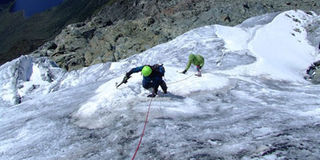Rwenzori, the heart of Africa

What you need to know:
THE HEIGHTS. The thrill of climbing Rwenzori gives each climber different vibes. Félix Romero shares his experience.
I went to Uganda to go back to magnificent nature. I met gorillas in Bwindi and chimpanzees in Kibale. I was so impressed by the purity of the lakes and savannah in Queen Elizabeth and Mburo. All these places touched me but Rwenzori made me feel special. It divides Africa on the Equator but more than that, if the rivers are the veins of the earth, Rwenzori Mountains are unquestionably, the heart of Africa. This place brings life- pumping water to the two main arteries of the continent, the Nile and the Congo Rivers. It is a unique place and a source of life for so many people and cultures along both rivers.
All natural and serene
In this remote corner of the earth you can hear the heartbeat of Africa and feel how pristine landscapes breathe, exhausted, and fearing the deforestation axe. You can experience the poverty, feeling it tear your soul, seeing the contrasts as you journey deeper and higher in Africa. There is an urgent need to find ways for halting poverty and deforestation. Mount Stanley at the Rwenzori is not only the highest mountain in Uganda it is the highest tropical mountain at the Equator in Africa. For mountaineers who look for purity of travelling, running away from artificially transformed circuits, to those seeking the essence of the explorer, pioneer, traveller and climber, this place makes you feel special. Compared to the overcrowded Kilimajaro, the mystical traveller will find something in Rwenzori. There are friendly people who chat and show you how it is possible to live embedded in a place full of richness such as freshwater, biodiversity, a beautiful landscape, glaciers and sunshine and at the same time struggle against poverty.
Sad side
Agonising reality is the tropical mountain glaciers irreversibly melting. Being on the Equator, this mountain is especially vulnerable to climate change effects. One night while talking to Reuben, one of our guides, he commented about the years when his father was a guide. Then, these glaciers poured from the summits over 5,400 metres to below 4,600 metres, to where Elena’s hut, the last camp is today. Just like Chimborazo, the highest peak in Ecuador, it took us almost two hours to reach the glacier of Mount Stanley.
It is disturbing, hearing the sound of ice just melting and running in dozens of creeks, below the ice under our feet. It is a paradox, that in a country with such evidences of climate change, the government’s priority is oil extraction.
On this steep terrain, in the dry season, farmers slash and burn almost everything. It is only the application of the law that protects the national park, thanks to its status as a conservation area. Because it is a growing source of income for the country and for local communities, the economy has contributed to and ensured the conservation of this wonderful place.
Sustainable approach
Today more than ever, visiting the national park for trekking or climbing is crucial as an alternative to deforestation. It is a source of income for the locals. Dozens of guides, porters, cooks and numerous families get an income, thanks to tourism that focuses on sustainability and attracting responsible visitors to these mountains.
Sustainable tourism is crucial to end poverty around Rwenzori Mountains. I saw Uganda Wildlife Authority (UWA) doing a good job in the national park. I got interesting feedback from Rwenzururu Kingdom on an environmental effort in the region. I discovered several companies and NGOs interested in creating value for visitors. One such NGO is World Wildlife Fund (WWF) currently implementing a project in the region to generate additional income for the Rwenzori Mountains National park by especially boosting tourism. Tourist incomes will help alleviate poverty.
Children will have education and opportunities to learn and develop their awareness and skills to protect nature from destruction to sustainability. In the medium and long term, it is crucial to engage the government and international donors in investing in the restoration of natural vegetation on these steep hillsides to create a buffer zone outside the national park. This will prevent soil erosion, conserve the freshwater below these mountains, and to ensure an additional source of income linked to forestry and agro-forestry.
The future
We cannot think of economic development as depleting mineral deposits or oil reservoirs because in this process of extinguishing non-renewable raw materials we accelerate climate change which is the primary and most urgent threat to the degradation of this unique landscape.




